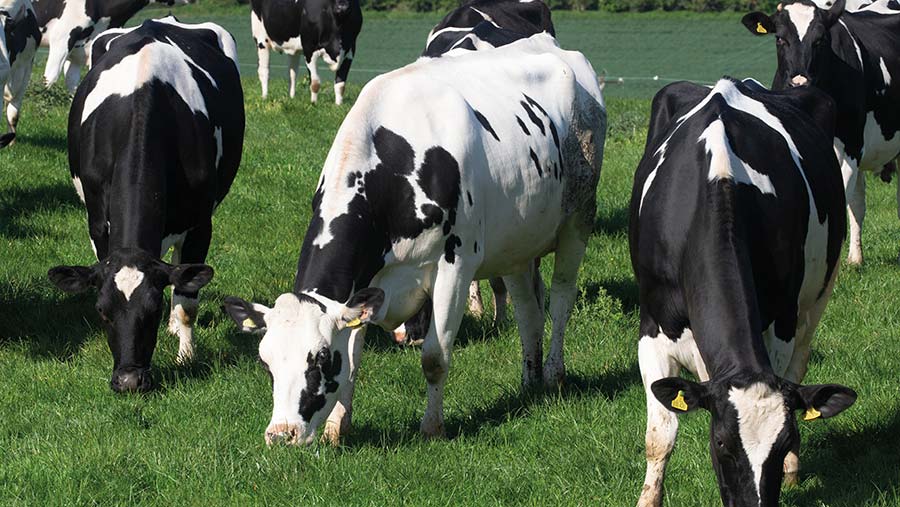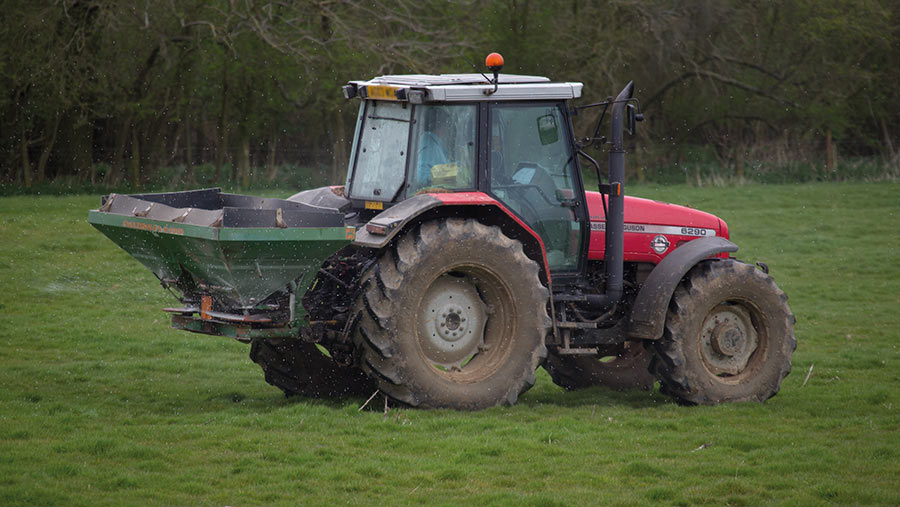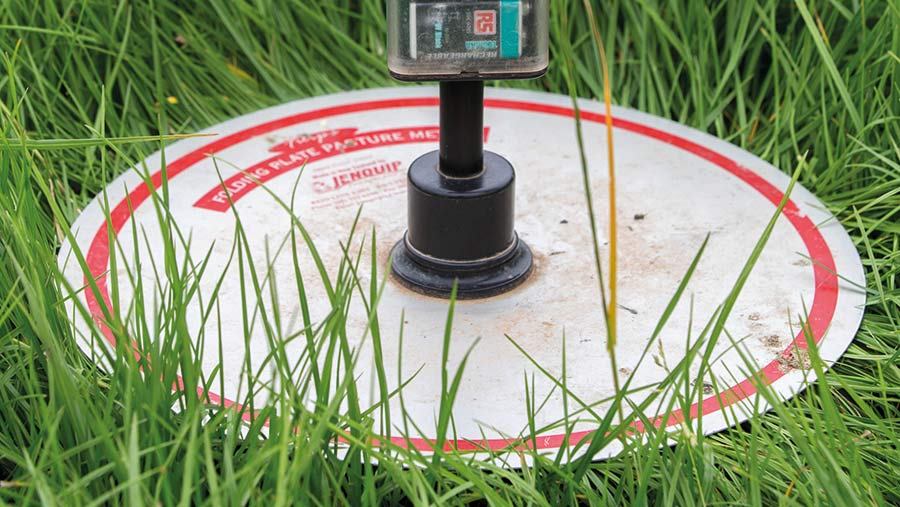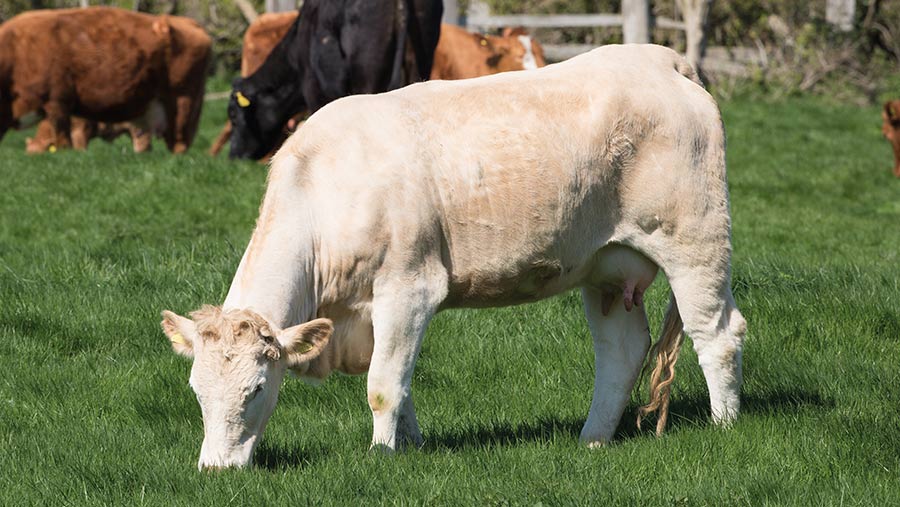Advice on using fresh grass analysis for nutritional value
 © Tim Scrivener
© Tim Scrivener Grass growth and composition could differ this spring compared with a typical year, as farmers seek to limit expensive fertiliser applications.
Deciding whether it is worth having fresh grass tested to gauge its nutritional value depends on a range of factors.
Independent beef and sheep consultant Liz Genever says there is a limit to what spring grass analysis can achieve.
See also: Buyer’s guide to grass-measuring equipment
Used strategically, it can add helpful information for use in livestock feeding and grassland management and may identify where any nutritional deficiencies lie. But much can be assessed by eye.
“If the grass is green to the base and leafy, spring grass is unlikely to be of poor quality in terms of its key metabolisable energy [ME] and crude protein [CP] values,” she says.
Ideally, these will reach an ME of 12-12.5MJ/kg dry matter (DM) and 18-25% CP early in the season.
However, lower nitrogen applications could feed through to slightly lower grass CP, which may persist until temperatures rise.
That is when any clover in the sward will start to fix atmospheric nitrogen to feed the growing crop.
Low nitrogen could be exacerbated by the generally mild winter. This has driven winter grass growth and may have depleted animal nitrogen returns and nitrogen mineralised from the soil.
“But lower protein is of limited consequence for the grazing animal early in the season, as protein is generally oversupplied in spring grass,” says Dr Genever.

© Tim Scrivener
Measure grass quantity
Lower grass growth rates and a lack of grass yield are greater concerns. These are likely to be more important consequences of any reduction in nitrogen availability.
A plate meter or a sward stick can provide guidance on the quantity of growth, giving a figure for grass covers expressed in kg DM/ha.
“For rotational grazing, plate metering should be carried out on a weekly basis, especially during the months when grass growth is increasing or high,” she says.
Low dry matters
Low dry matter content can be a further concern in spring and exacerbate the problem of insufficient covers.
“Dry matter can be as low as 15% in spring, especially after spells of rain,” Dr Genever says.
Although this is the most critical and variable test for grass, it is probably the easiest and cheapest to do, requiring little more than scales and a microwave oven.
“Grass with low DM and high protein, typical of spring conditions, can move through the rumen quickly, so is insufficiently digested when it reaches the lower intestine. This can cause dietary upsets,” she says.
Added to this is the need to reach target DM intakes, which can be a challenge in a grazing-based diet if grass DM is low.

© Tim Scrivener
Analysis can build confidence
Other forms of grass analysis require the use of a lab, which Dr Genever says should not be carried out “for the sake of it”.
However, producers with concerns about grass quality may gain confidence from the results.
Three types of analysis should be considered – a nutritional, trace element or tissue analysis.
In all cases, grass should be sampled using scissors or shears, from random points across each field.
“Make sure you sample leaf and avoid any contamination,” she says. “This is the part the animal will eat, rather than anything dead or stemmy, which they are likely to reject.
“For nutritional analyses, send the sample to the lab that carries out your silage analysis, but make sure it is identified as fresh grass,” she says.

© Tim Scrivener
Nutritional analysis
The key parameters of a nutritional analysis are ME and CP, both of which can inform feeding and management.
She says: “Low-protein swards may benefit from a nitrogen application, but at current fertiliser prices, should be carefully considered.”
This means concentrating applications on the fields most likely to respond, such as those with productive grasses, facing south, with the right pH (close to 6.5) and with good phosphorus (P) and potassium (K) status.
“Applications to these fields may just be cost-effective, but other fields may not give a return,” Dr Genever says.
However, new work, shortly to be published by the AHDB, will put a financial figure on returns at today’s fertiliser prices.
A low ME is also unlikely in spring grass and should initially be checked for sampling errors.
“Producers can use the information from a nutritional analysis to determine whether stock need supplementary feeding,” she says.
“However, it’s important to understand whether they need an energy boost or just dry matter.
“An energy deficit could be addressed with licks or concentrates, but if they need more DM, this could be supplied through forages such as fodder beet or silage.”
Trace element analysis
Trace element analysis fulfils a different role and is normally undertaken in the face of deficiency concerns.
These could relate to previous history and could determine the need for supplementation, such as with a bolus or mineralised feed.
Dr Genever says: “If inputs have been reduced this year in response to rising costs, producers may need to reflect on how their stock will receive their micronutrients, if fortified supplementary feed has been cut.”
Tissue sample analysis
A tissue sample analysis can test for a range of plant nutrients, most importantly nitrogen and sulphur.
It may be prompted by grass appearing to be less green which suggests it may be struggling for nutrition.
“Sulphur deficiency in grass looks like nitrogen deficiency from a distance,” she says.
“But if grass looks yellow after the recommended amount of nitrogen has been applied, it is probably deficient in sulphur.
“I’ve seen a lot of people investigating this already this season, as they are recognising its value,” she continues.
“[Analysis] will enable them to plan their fertiliser programme more accurately and cost-effectively, and with less wastage and more environmental responsibility.”
However, she urges grassland farmers to think hard before spending money on testing which may not be required.
“If the test answers a specific query about a field, helps build your confidence, or you have radically changed your nitrogen applications, it may be worthwhile,” she says.
“However, farmers could also refer to data from the AHDB’s Forage for Knowledge or GrassCheckGB,” she says.
“These initiatives publish regular national and regional grass growth and composition figures from participating farmers across the UK, which could give guidance to those who choose not to sample their own.”
AHDB Grass Campaign
This article forms part of the AHDB Grass Campaign, which aims to help producers make better use of home-grown grass swards, both grazed and conserved.
You can get further information from:
